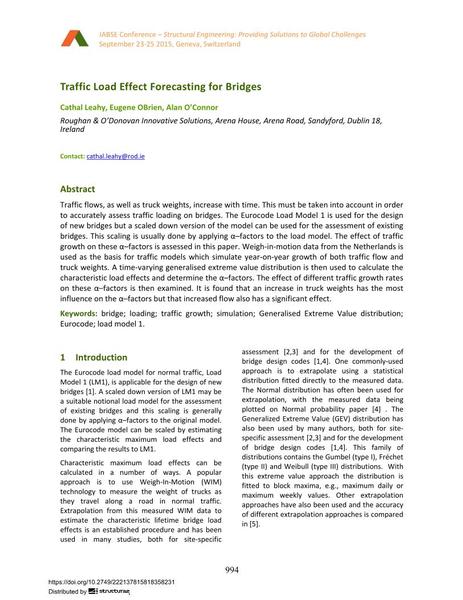Traffic Load Effect Forecasting for Bridges

|
|
|||||||||||
Bibliographic Details
| Author(s): |
Cathal Leahy
(Roughan & O’Donovan Innovative Solutions, Arena House, Arena Road, Sandyford, Dublin 18, Ireland)
Eugene Obrien (Roughan & O’Donovan Innovative Solutions, Arena House, Arena Road, Sandyford, Dublin 18, Ireland) Alan O'Connor (Roughan & O’Donovan Innovative Solutions, Arena House, Arena Road, Sandyford, Dublin 18, Ireland) |
||||
|---|---|---|---|---|---|
| Medium: | conference paper | ||||
| Language(s): | English | ||||
| Conference: | IABSE Conference: Structural Engineering: Providing Solutions to Global Challenges, Geneva, Switzerland, September 2015 | ||||
| Published in: | IABSE Conference Geneva 2015 | ||||
|
|||||
| Page(s): | 994-1001 | ||||
| Total no. of pages: | 8 | ||||
| Year: | 2015 | ||||
| DOI: | 10.2749/222137815818358231 | ||||
| Abstract: |
Traffic flows, as well as truck weights, increase with time. This must be taken into account in order to accurately assess traffic loading on bridges. The Eurocode Load Model 1 is used for the design of new bridges but a scaled down version of the model can be used for the assessment of existing bridges. This scaling is usually done by applying α–factors to the load model. The effect of traffic growth on these α–factors is assessed in this paper. Weigh-in-motion data from the Netherlands is used as the basis for traffic models which simulate year-on-year growth of both traffic flow and truck weights. A time-varying generalised extreme value distribution is then used to calculate the characteristic load effects and determine the α–factors. The effect of different traffic growth rates on these α–factors is then examined. It is found that an increase in truck weights has the most influence on the α–factors but that increased flow also has a significant effect. |
||||
| Keywords: |
bridge Eurocode loading simulation traffic growth Generalised Extreme Value distribution load model 1
|
||||
